The Preservation of an Archaeological Site : Part 2
Preservation conditions for Organic Materials

As a general rule, organic remains are best preserved where the impact of chemical, biological and physical agents of destruction is restricted. Organic objects made of living substances such as wood, leather, bone and cotton are preserved mainly under environmental conditions. These include water logged deposits (wetlands and peat bogs),cold or Arctic conditions and dry or desert like environments. Organic material decays very rapidly. There will therefore always be an unfilled gap in the cultural interpretation of prehistoric sites, because there are always a large number of objects manufactured from perishable organic material such as bone, wood, leather, hair or vegetable fabrics. Organic material often leaves traces of its existence in the ground. Thus, for example, the ground plan of many Neolithic dwellings in Europe has been established by studying the variations in the color of the earth caused by the decay of the wooden stakes used for building the dwellings.
Inorganic compounds and Organic stuff
Inorganic compounds are typically of a mineral, not biological origin. Organic matter (or organic material) is matter that has come from a once living organism, is capable of decay, or the product of decay, or is composed of organic compounds.
The degree of preservation of both inorganic and organic material - but particularly organic material - is of course to a large extent dependent on the climate. When the excavated finds are examined, all factors which may have determined the contents of a site should be considered, since these may influence the reconstruction of past life-ways.
The fact that specific objects do not occur at a site is not necessarily proof that the inhabitants were not acquainted with them. A study of the geological matrix and archaeological context of finds, including preservation conditions and formation processes, is a prerequisite for the meaningful interpretation of a site's contents and the history of its former inhabitants.
Waterlogged Deposits (Wetlands and Peat Bogs)
In acidic bogs wood and plant remains preserve exceptionally well, whereas bone, iron and even pottery may disintegrate. Inland lakes and marshes often preserve objects that have been manufactured from organic material, for example the lake dwellings in the Alpine regions.

Tollund Man
The discovery of the corpse of Tollund man in a peat bog in Denmark some 2000 years after his death is another good example of the preservation of organic material in waterlogged conditions. Wet preservation caused by a mud slide at the Ozette site, Washington, protected the village for two centuries until the action of the sea exposed some of the remains. Over 50 000 artefacts were subsequently recovered, many of which were manufactured from wood and woven.
Cold or Arctic Conditions
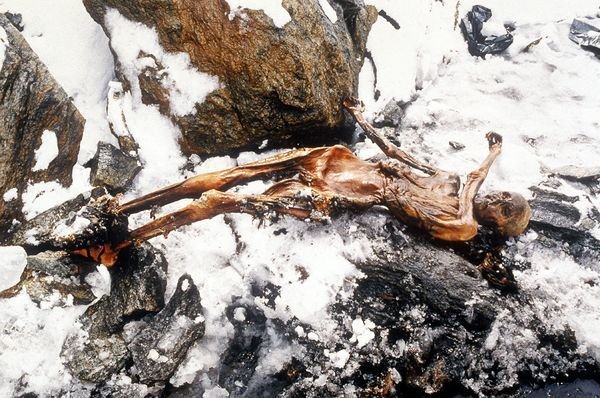
Otzi the Ice Man
A very cold climate provides the most favorable conditions for preservation. A classic example is that of north-eastern Siberia where mammoths have been preserved, as it were, in ice strata. One of the most remarkable discoveries was made when 19 September 1991 a German couple stumbled upon the body of a Copper Age inhabitant of Europe in a glacier in the Alps on the border between Italy and Austria. Rabiocarbon tests indicate that the "Ice Man", as he was dubbed, died about 5000 years ago. His body is the oldest, complete human body ever discovered. Various weapons and tools were found together with the body, among others a copper axe, a knife with a flint blade, a pouch, a bone needle, arrows, a quiver and a bow. This finds sheds new light on the way of life of prehistoric humans in Europe during the Copper Age.

Otzi the Ice Man with the items found with him.
Frozen conditions at the site of Pazyryk in Southern Siberia helped to preserve steppe nomads found in burial mounds dating from approximately 400 BC. Grave goods of wood, articles of clothing made of cloth, felt and leather, and even the tattoo patterns on the bodies were found in an excellent state of preservation.
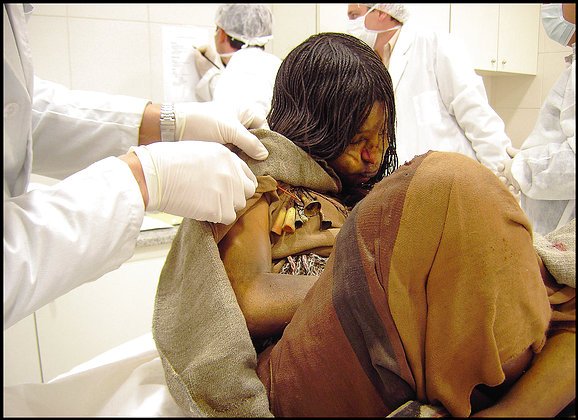
Inca Mummy Bundle
The Inca human sacrifices (mummy bundles) placed on high mountain peaks in the Andes were also particularly well preserved by the extreme cold.
Dry or Desert-Like Environments
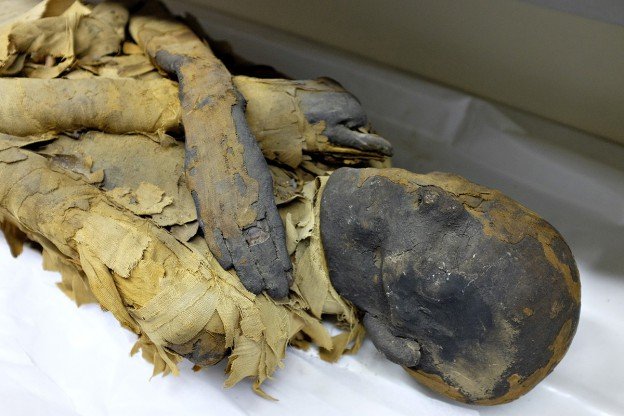
Egyptian Mummy
Even organic material has been preserved in a dry desert climate, such as that in Egypt and Asia. The dry atmosphere and the rapid drying out of wrapped bodies placed in the sand in desert regions and in coastal cemeteries and dry caves and rock shelters in the American Southwest and in Peru are conductive to the preservation of such bodies, often with skin, hair and nails intact, as well as the accompanying grave goods. In the Aleutian islands off Alaska the dead were placed in very dry, volcanic-ally warm caves.
Warm and Damp Conditions
The warm and damp conditions of the equatorial and the tropical rain belt regions are not conducive to the preservation of organic matter.
Taphonomy
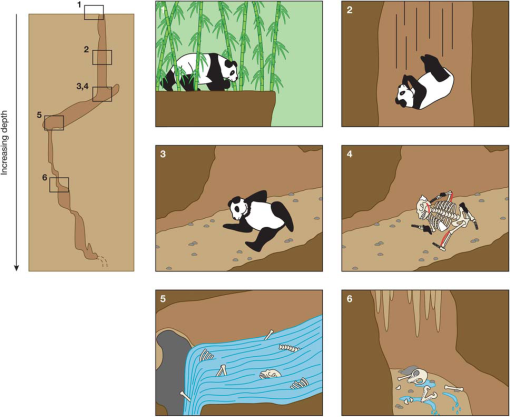
In order to interpret the relative abundance of different types of organic remains in archaeological sites, many archaeologists have become involved in Taphonomic studies. Broadly defined, Taphonomy is the study of what happens to organic remains after death. It involves examining the different rates of decomposition between different organic materials.
Temperate climates
Similarly, a temperate climate as found in Europe and North America is generally regarded as unfavourable.
Special Conditions and Natural Disasters
It is self-evident that local conditions at each particular site also influence the standard of preservation, caves and rock shelters afford an example of this. The mummified remains of a San Hunter - gather that are almost 2000 years old were found buried in a deep grave 0.80m covered with Boophane disticha leaves in a rock shelter in the foothills of the Kouga Mountains near Loubertina, in the Eastern Cape Province.
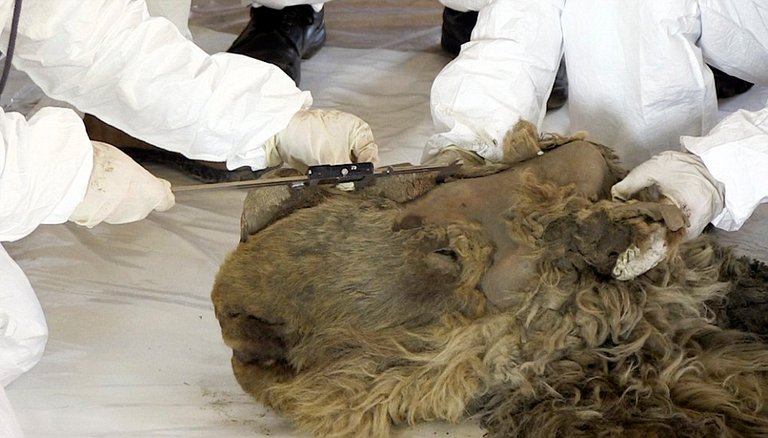
Sasha Baby Woolly Rhinoceros
Organic materials may also be well preserved in Salt mines, for example in the Iron Age mines at Hallstatt, Austria. In Poland a woolly rhinoceros was found with the skin intact in a pool saturated with crude oil and salt. Prehistoric animals and birds were preserved in the asphalt pits of La Brea, Los Angeles.

Skeletons of Pompeii
Natural disasters such as violent storms ( a sand storm covered the Neolithic village of Skara Brae in the Orkney Islands), mud slides (the Ozette site in America) or volcanic eruptions (Vesuvius which buried and preserved Pompeii) sometimes preserve whole sites or villages.
Preservation of Human Remains: The Mummy Line-up
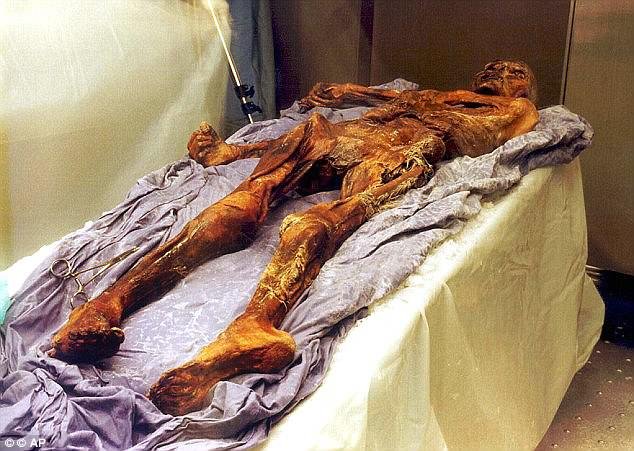
1. Name: Otzi
Location: alps, Austria/Italy
Preservation: Excellent
Preservation Situation: Cold/Artic conditions
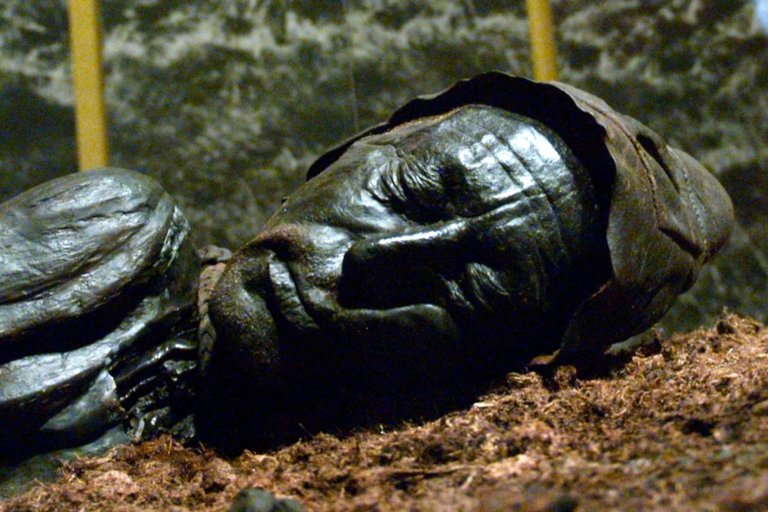
2. Name: Tollund Man
Location: Denmark
Preservation: Excellent
Preservation Situation: Peat Bog conditions
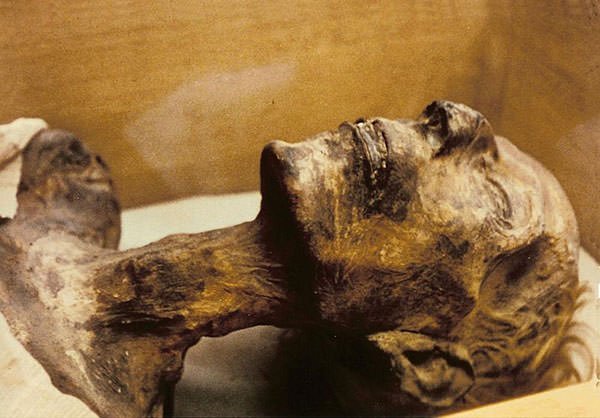
3. Name: Ramessess II
Location: Egypt
Preservation: Excellent
Preservation Situation: Dry/Desert - like conditions
Preservation conditions for Inorganic Materials
Inorganic material is, generally speaking, more durable than organic material. Inorganic materials include artefacts made of stone, clay, glass and metals such gold, copper, silver and bronze.
Stone
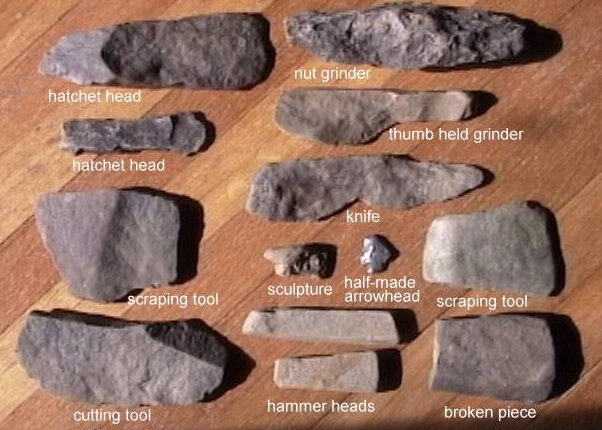
Stonework is very durable, but even so, traces of the dressing process applied to the stones may be obiliterated by chemical action in acid soil. Stone tools are the most durable of material cultural objects, but may also undergo changes through mechanical weathering or chemical processes. Stone implements represent an important source in reconstructing human activities during the Stone Age as wood and bone tools are less likely to have been preserved.
Clay, Porcelain and Glass
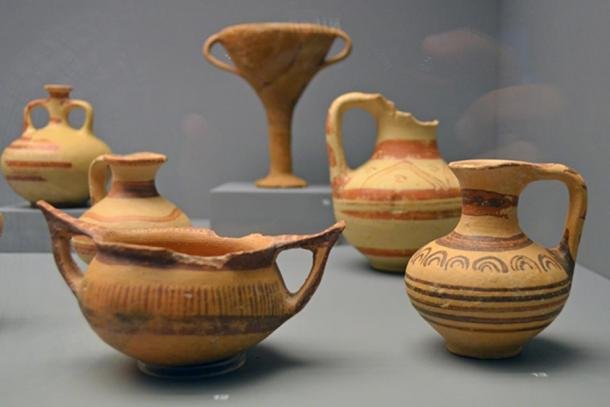
The durability of baked clay in the form of bricks, pottery, adobe or dagha depends to a large extent on its degree of vitrification. Clay is almost indestructible if well fired and ceramics represent some of the main sources of archaeological evidence. Clay may disintegrate in humid conditions. Porcelain is practically imperishable, as is glass.
Metals
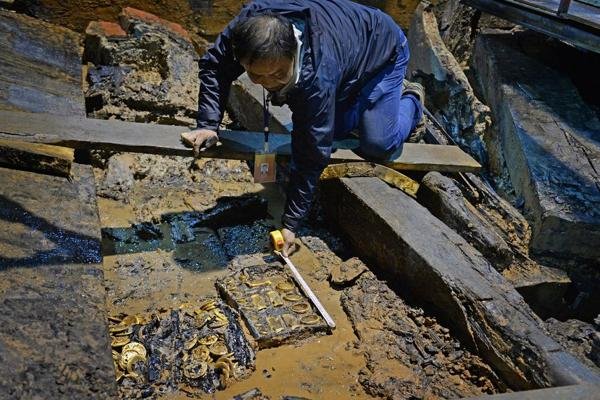
Chinese archaeologists discovered 75 gold coins and hoof-shaped ingots in the tomb
Of the metals, gold is practically immutable. Silver , lead , copper and bronze are fairly durable, but become oxidised in acid soils and are covered with a green deposit.
Sometimes only a green stain indicates the presence of a copper artefact: copper ear and arm ornaments left green discoloration on specific parts of skeletons in the Iron Age burials. Copper salts also have preservation action which prevents the activity of destructive micro-organisms.
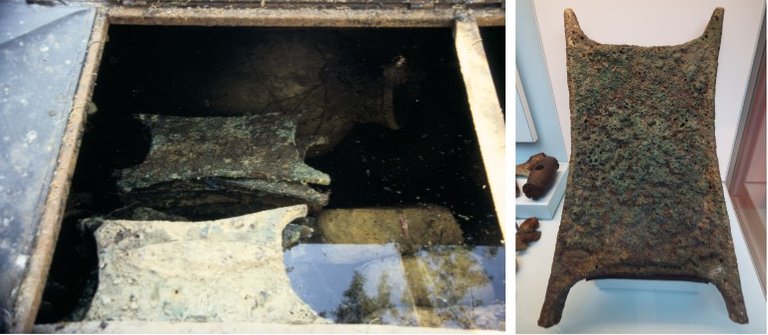
Copper Ingot
Organic packing material, wrapped around copper ingots found in the 14th century BC Uluburun shipwreck off the south coast of Turkey, was preserved for this reason.

Copper Alloy Roman Coins
Iron is quick to rust, especially in a damp climate, as a result of the process of oxidisation. Iron remains are sometimes identifiable by staining of the soil and a cast of such a feature may be made in order to reconstruct the shape of the original object. Iron artefacts recovered from the sea are usually coated with metallic salts deriving from the iron objects themselves.
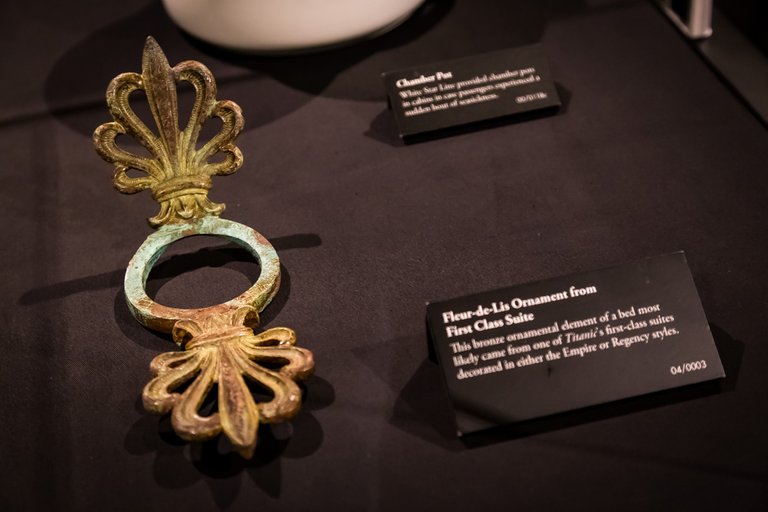
Artefact from the Titanic
The standard procedure in underwater archaeology is to submerge such artefacts in a chemical solution in a container enclosed by a metal grill. A weak electrical current is passed through the water (electrolysis, which causes the metallic salts to move to the grill (anode). This method was also used on finds recovered from the Titanic.
References: Bahn (1996)
Fagan (1996/97)
Please Follow me for more on Archaeology and History.
Please check out my other posts:
The Preservation of an Archaeological Site : Part 1
Discovering your own Archaeological Site : Part 3
Discovering your own Archaeological Site : Part 2
Discovering your own Archaeological Site : Part 1
Archaeological Sealed Sites and River Deposits : Is it an Archaeological Site or Not? - Part 3
Caves, Rock Shelters and Larger Open-Air Sites : Is it an Archaeological Site or Not? - Part 2
Is it an Archaeological Site or Not? - Part 1
Understanding the Archaeological Record : The Aims and Subject Matter of Archaeology - Part 2
The Aims and Subject Matter of Archaeology - Part 1
Archaeology and the Natural Sciences
Introduction to Ethnographic Analogy and Ethnoarchaeology
The Nature and Scope of Archaeology
The Three - Age System : The Stone Age, The Bronze Age and The Iron Age
The Roots of Modern Archaeology
Significant 18th and 19th Centuries Discoveries in Archaeology
Archaeology as a Profession- Part 2
Archaeology as a Profession- Part 1
To Become or Not Become an Archaeologist? - Introduction to Archaeology Part 2
Please Upvote and Resteem.
Thank You!
It is always amazing to see what ice can do in terms of preservation!
I totally agree @lemouth. The details are kept in nearly perfect condition.
I've heard of all of the preserved bodies you mentioned. It really is amazing how well mother nature preserves some things. The one Inca woman is incredible looking.
She looks like she would come back to life any moment.